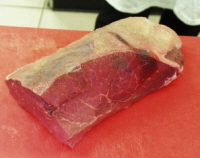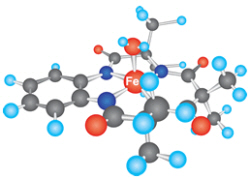



The Big Question Over Beef Hormones
The question over whether beef cattle should be treated with artificial hormones can be perceived on many different levels - be they physiological, political, economical, ethical, or environmental - each answer they evoke blinds one belief to another. Perhaps this explains why it is at the heart of the single longest dispute that the World Trade Organization has ever had to deal with, writes Adam Anson, reporting for TheBeefSite.
Photo: Stock.xchng
In essence it is a question of risk analysis and statistics hampered by a mass of differing evidence. The US and Canada on the one side, who believe that a broad scientific consensus exists on the side of hormone safety , and the European Union on the other, erring on the side of caution in a matter of grave consequence.
In the middle, we have the World Trade Organization (WTO), the only international body to deal with the rules of trade between nations. It is their role to decide if countries should pay sanctions for not opening their markets to free trade. Their verdict is based on whether or not nations can give a sound scientific reason not to trade with another nation. In this example: is US/Canadian, hormone treated beef safe for EU consumption?
In its most recent decision the WTO Appellate Body concluded that the United States did not violate its WTO obligations by maintaining additional duties on certain EU products. Consequently, sanctions to the value of $125 million were upheld against the EU nations.
More for Less?
It all began in the 1990's, back in the midst of another great food safety question, this time posed by the severity of the mad cow disease outbreak in the UK. Under pressure from its citizens the European Union banned the import of meat that contained artificial beef hormones - a move that was portrayed to rural constituencies in the U.S. and Canada as protectionism.
Canada and the United States opposed this ban, taking the EU to the WTO Dispute Settlement Body. In 1997, the WTO ruled against the EU. The EU appealed the ruling and lost. The WTO authorised the United States to raise tariffs on imports from the EU, which the United States put into effect in 1999.
There are six hormones approved for use in beef production in more than 30 countries. Three of these are natural, three synthetic. Except for MGA (administered via feed), FDA regulations only allow growth promoting hormones to be administered through time-release implants placed under the skin of the animals’ ear. Each implant contains a specific, legally authorized dose of hormones.
The hormone drugs have been banned in Europe for 20 years but they are still used in Australia, New Zealand, the United States, Canada, Mexico and Chile. Scientists believe about two-thirds of American cattle raised in for slaughter today are injected with hormones to make them grow faster.
They have been used in America for over 50 years where producers have benefited from lower costs allowing them to produce more from less. Many producers tout the environmental benefits to be gained from the use of these products. Increased feed use efficiency, reduced land requirements, and reduced greenhouse gas emissions per pound of beef produced have all been conclusively demonstrated.
An experiment conducted by the Iowa State University concluded that growth promoting hormones and ionophores decrease the land required to produce a pound of beef by two thirds, with fully one fifth of this gain resulting from growth enhancing pharmaceuticals. Whereas grass-based organic beef requires more than 5 acre-days to produce a pound of beef, less than 1.7 acre days are needed in a grain-fed feedlot system using growth promotants.
According to the results, grain feeding combined with growth promotants also results in a nearly 40 per cent reduction in greenhouse gases (GHGs) per pound of beef compared to grass feeding (excluding nitrous oxides), with growth promotants accounting for fully 25 per cent of the emissions reductions.
However, other studies have brought to light concern over the environmental impacts of hormone residues in cattle manure. When manure from factory farms enters the surrounding environment, these hormones can contaminate surface and groundwater. Aquatic ecosystems are particularly vulnerable to hormone residues. Recent studies have demonstrated that exposure to hormones has a substantial effect on the gender and reproductive capacity of fish, throwing off the natural cycle.
But fish are not the main concern for protest. Human beings are - or more specifically - children.
Growing Fears: True or Artificial?
According to multiple studies, children are particularly sensitive to these hormones. The studies suggest that these hormones can cause sudden growth or breast development, even at levels which are difficult to detect in the laboratory. Some reports went as far as saying that the unborn children of pregnant women could be abnormally affected by the hormones.
In 2006, the United States Department of Agriculture's very own Agriculture and Research Service reported on the potential use of an enzyme-like catalyst that, in lab tests, rapidly breaks down natural and synthetic forms of the hormone oestrogen. The report stated that "The catalyst has potential for preventing the hormone's escape into the environment." It went on to highlight "growing concern that hormones—whether flushed into sewage or excreted by livestock—can disrupt the endocrine systems of fish, other wildlife and potentially humans."

Image: Carnegie Mellon University.
A Veterinary Products Committee’s report was finalised in January 2008 and concluded: “The weight of evidence at present available suggests that the likely levels of human exposure to hormonally active substances in meat from treated animals would not be sufficient to induce any measurable physiological effect.”
However, it was reported that John Verrall, a pharmaceutical chemist and consumer representative on the Veterinary Products Committee, refused to endorse a report by the committee that effectively says the hormones are safe.
He said that a number of important studies have shown that the information used by regulators to assess the safety of hormone residues in food has been wildly inaccurate.
“It is now clear that very much smaller amounts of sex hormones in food than previously thought can cause genital abnormalities in baby boys, premature puberty in girls and increase the risk of cancers later in life”, he said.
The agency, United State Trade Representative, said. "The human body is continually making the natural hormones that are subject to the EU’s ban, and these hormones also occur naturally in foods such as eggs and butter, often in concentrations substantially greater than in meat from cattle treated with these hormones."
According to them, this assessment is shared not only by the Food and Drug Administration of the United States and Health Canada, but also by the Codex Alimentarius Committee of the World Trade Organization, the Food and Agriculture Organization of the United Nations, the World Health Organization, and even a conference established by the European Agriculture Commission.
Consequently the EU have not brought sufficient evidence to the WTO to legally prevent the trade. However, they now ascertain that the the panel made legal errors in its verdict. In particular, the EU believes the panel:
- "was not entitled to make findings on this matter";
- "failed to establish the facts objectively";
- "exceeded its powers by selectively relying on scientific experts that lacked the required impartiality, rather than accepting the existence of legitimate scientific controversy and uncertainty";
- "erred in putting on the EU the burden to demonstrate the WTO-compatibility of its hormones directive";
- "applied inappropriate standards regarding the required scientific basis for health protection measures."
October 2008


